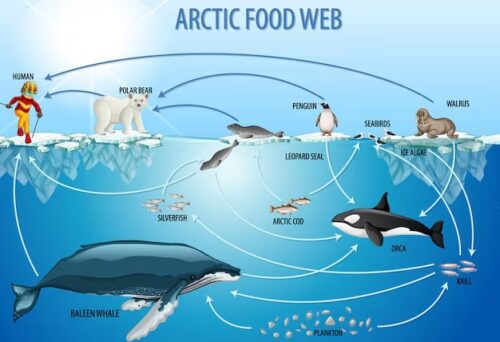The Marine Food Web: Who Eats Whom in the Underwater World?
When we dive, we are mesmerized by individuals: a colorful parrotfish, a lurking grouper, a tiny nudibranch. But in reality, no creature exists in a vacuum. They are all part of a vast, complex, and invisible network of energy: the food web.
In this article from the Amadive Marine Ecology series, we will help you see those connecting threads. Understanding the food web will transform your dive from a “gallery viewing” into reading a living story of life, death, and the flow of energy that has sustained the oceans for millions of years.
The Foundation of All Life: The Producers

All energy on Earth originates from the sun, and the ocean is no exception.
- Phytoplankton: Forget the terrestrial rainforests. These microscopic, floating, single-celled plants are the true lungs of the planet. They use photosynthesis to convert sunlight into energy, and in the process, they produce more than 50% of the oxygen we breathe. They are the first trophic level and the foundation of nearly all life in the ocean.
- Algae: Larger forms of algae that grow on reefs and rocks are also important producers.
The Second Trophic Level: The Primary Consumers
These are the herbivores, the “gardeners” of the reef.
- Their Role: They eat algae, keeping it in check. Without them, algae would overgrow, block out sunlight, and suffocate the coral.
- Characters You’ll See:
- Parrotfish: Use their hard beaks to scrape algae off dead coral skeletons. Their poop is the fine white sand you see on tropical beaches!
- Surgeonfish: Like lawnmowers, they travel in large schools, grazing on patches of algae.
- Sea Urchins: The diligent “vacuum cleaners” of the reef at night.
The Third Trophic Level: The Secondary Consumers
These are the carnivores that prey on the herbivores.
- Their Role: They control the populations of herbivores, ensuring they don’t consume all the algae.
- Characters You’ll See:
- Groupers: Ambush predators, often hiding in crevices.
- Lionfish: An efficient hunter (and an invasive species in many parts of the world).
- Moray Eels: Nocturnal hunters with an incredible sense of smell.
Higher Levels and Apex Consumers (Tertiary/Apex)
These are the predators that eat other carnivores.
- Their Role: At the top of the food web, they maintain the balance of the entire system, as discussed in our article on the role of sharks.
- Examples: Great Barracuda, Tuna, and Sharks.
The Final Loop: The Decomposers
- Their Role: When an organism dies, its energy is not wasted. Creatures like shrimp, crabs, and billions of bacteria break down the dead matter, returning essential nutrients to the water, where they can be used again by the producers, the phytoplankton.
From “Chain” to “Web”
In reality, it’s more complex than a straight chain. Most animals eat a variety of things, creating an intricate food web. A crab might be both a herbivore (eating algae) and a decomposer (eating a dead fish).
Conclusion: Every Creature Has a Role
When you understand the food web, every creature you see takes on new meaning. The parrotfish isn’t just beautiful; it’s a gardener. The grouper isn’t just big; it’s a manager. The nudibranch isn’t just tiny; it’s part of a grand story of energy. Every dive is a chance to witness this web of life in perfect, functioning order.
